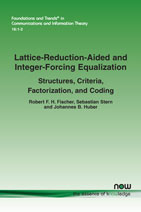Lattice-Reduction-Aided and Integer-Forcing Equalization: Structures, Criteria, Factorization, and Coding
By Robert F. H. Fischer, Ulm University, Germany, robert.fischer@uni-ulm.de | Sebastian Stern, Ulm University, Germany, sebastian.stern@uni-ulm.de | Johannes B. Huber, Friedrich-Alexander-Universität Erlangen-Nürnberg, Germany, johannes.huber@fau.de
Abstract
In this monograph, a tutorial review of lattice-reductionaided (LRA) and integer-forcing (IF) equalization approaches inMIMO communications is given. Both methods have in common that integer linear combinations are decoded; the remaining integer interference is resolved subsequently. The aim is to enlighten similarities and differences of both approaches. The various criteria for selecting the integer linear combinations available in the literature are summarized in a unified way. Thereby, we clearly distinguish between the criteria according to which the non-integer equalization part is optimized and those, which are inherently considered in the applied lattice algorithms, i.e., constraints on the integer equalization part. The demands on the signal constellations and coding schemes are discussed in detail. We treat LRA/IF approaches for receiver-side linear equalization and decision-feedback equalization, as well as transmitter-side linear preequalization and precoding.
Lattice-Reduction-Aided and Integer-Forcing Equalization: Structures, Criteria, Factorization, and Coding
This monograph provides a tutorial review of the Lattice-Reduction-Aided and Integer-Forcing approaches to equalization in MIMO communications. The authors highlight the similarities and differences of both approaches while summarizing the various criteria for selecting the integer linear combinations available in the literature in a unified way. This presents the reader with a clear overview of the differing equalization techniques and enables them to be adopted for any particular system under development. The authors proceed to consider the demands on the signal constellations and coding schemes in detail.
The monograph provides a concise overview of recent developments in the development of the widely-used MIMO communication systems. It is of interest to researchers, practitioners and students alike.
